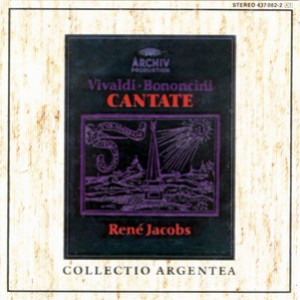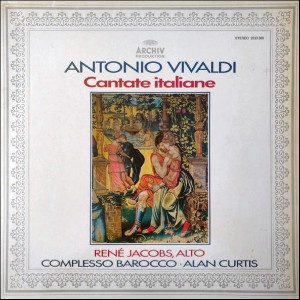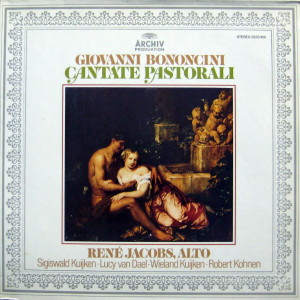 |
|
1 CD -
437 082-2 - (c) 1986
|
 |
| 1 LP -
2533 385 - (p) 1978 |
 |
| 1 LP -
2533 450 - (p) 1980 |
|
| ANTONIO VIVALDI
· GIOVANNI BONONCINI - Cantate |
|
|
|
|
|
Antonio
Vivaldi (1678-1741) *
|
|
|
| Cessate, omai
cessate RV 684 - MS, Turin,
Biblioteca nazionale universitaria |
13'
24" |
|
| - Recitativo
accompagnato: "Cessate, ormai
cessate" |
2'
12" |
|
| - Aria: "Ah
ch'infelice sempre" |
5'
54" |
|
| - Recitativo
accompagnato: "A voi dunque
ricorro" |
1'
23" |
|
| - Aria: "Nell'orrido
albergo" |
3'
55" |
|
| O mio porpore più
belle RV 685 - MS, Turin,
Biblioteca nazionale universitaria |
8'
36" |
|
| - Aria: "O mie
porpore più belle" |
5'
03" |
|
| -
Recitativo: "Tutta vaga e
festosa" |
0'
23" |
|
| - Aria: "Non vidi
il più gentile"
|
3' 10" |
|
| Amor hai vinto
RV 683 - MS, Turin, Biblioteca
nazionale universitaria |
14' 27" |
|
| -
Recitativo: "Amor hai vinto" |
1'
11" |
|
| - Aria: "Passo di
pena in pena" |
6'
23" |
|
| - Recitativo
accompagnato: "In che strano e
confuso" |
1'
47" |
|
| - Aria: "Se a me
rivolge il ciglio" |
5'
06" |
|
|
|
|
| Giovanni
Bononcini (1670-1747) |
|
|
| Siedi, Amarilli
mia, siedi e m'ascolta -
Cantate e Duetti/dedicati/alla
Sacra Maestà/di/Giorgio Re della
Gran Bretagna & c./Da/Giovanni
Bononcini/Londra MDCCXXI |
13'
01" |
|
| - Preludio |
2'
21" |
|
| - Aria: "Siedi,
Amarilli mia" |
6'
33" |
|
| -
Recitativo: "Ah sì, che i
tuoi begl'occhi" |
0'
49" |
|
| - Aria: "Se
scherza e ride" |
3'
18" |
|
| Care luci del
mio bene - Cantate e
Duetti/dedicati/alla Sacra
Maestà/di/Giorgio Re della Gran
Bretagna & c./Da/Giovanni
Bononcini/Londra MDCCXXI |
10'
28" |
|
| - Aria: "Care luci
del mio bene" |
6'
16" |
|
| -
Recitativo: "Ah Nice, poichè
volse" |
1'
02" |
|
| - Aria: "Più vaga
e vezzosetta" |
3'
10" |
|
|
|
|
| René Jacobs,
Countertenor |
René Jacobs, Countertenor |
|
COMPLESSO BAROCCO
(on authentic instruments) *
|
Sigiswald Kuijken,
Lucy van Dael, violin |
|
- Lucy van Dael,
Mihoko Kimura, Thomas Albert, Keiko
Watanabe, violin *
|
Wieland Kuijken, violoncello |
|
- Marten Boeken, viola
(alto) *
|
Robert Kohnen, harpsichord |
|
- Lidewij Scheifes,
violoncello *
|
|
|
- Nicholas Pap, double
bass *
|
|
|
Alan Curtis,
Directed from the harpsichord *
|
|
|
|
|
|
|
Luogo
e data di registrazione |
|
- St.
Anna en Maria, Haarlem (Olanda) -
ottobre 1977 (Vivaldi)
- St. Stephanuskerk,
Mereleke-Melsen (Olanda) -
settembre 1979 (Bononcini) |
|
|
Registrazione:
live / studio |
|
studio |
|
|
Producer /
Engineer |
|
Andreas
Holschneider - Gerd Ploebsch /
Hans-Peter Schweigmann (Vivaldi) -
Onno Scholtze (Bononcini) |
|
|
Prima Edizione
LP |
|
-
Archiv - 2533 385 - (1 lp) -
durata 48' 47" - (p) 1978 -
Analogico - (Vivaldi - parziale)
- Archiv - 2533 450 - (1 lp) -
durata 52' 01" - (p) 1980 -
Analogico - (Bononcini - parziale)
|
|
|
Edizione
"Collectio" CD |
|
Archiv
- 437 082-2 - (1 cd) - durata 60'
14" - (c) 1986 - ADD |
|
|
Note |
|
- |
|
|
|
|
VIVALDI ·
BONONCINI:
CANTATAS
If
Vivaldi’s Cantatas were less
widely known than his
concertos during the 18th
century, they were at least
spared the barbs of
Contemporary critics.
Indeed, the historian
Charles Burney, who declared
in 1789 that the chief merit
of the Vivaldi concertos in
the collection entitled La
stravaganza was their
“rapid execution”, softened
his attitude considerably
when he came to review the
Cantatas. He observed: “Don
Antonio Vivaldi merits a
place among the candidates
for fame in this species of
composition... [which] are
very common and quiet,
notwithstanding he was so
riotous in composing for
violins. But he had been too
long used to write for the
voice, to treat it like an
instrument.” Burney’s
tribute to Vivaldi’s ability
to write idiomatically for
the voice echoes a remark
made 50 years earlier by the
German composer and critic Johann
Mattheson, for whom
“Vivaldi, although no singer
himself has been able to
keep violinistic leaps out
of his vocal pieces so
successfully that his arias
have become a reproach to
many practised composers of
vocal music”. Only Tartini,
as reported by Charles de
Brosses in 1739, seems to
have dissented from this
commendation of Vivaldi as a
composer for the voice, and
he may have been motivated
by simple jealousy.
The Cantata was a
musical-poetic genre whose
social milieu was much more
restricted than that of the
contemporary opera. Its
natural home was the conversazione
or accademia of
courtly or learned society.
Although Vivaldi, whose
sense of showmanship and
entrepreneurial leanings
caused him to direct his
main efforts towards a wider
public, remained on the
fringes of these
intellectually oriented
circles, the opportunity to
write cantatas came his way
at various times during his
career. At the Ospedale
della Pietà,
the home for foundlings in
Venice where he served for
many years as a violin
teacher, a certain amount of
secular vocal music was
cultivated for the private
enjoyment of the governors
and their wards. But it was
during the period 1718-20,
when Vivaldi worked in
Mantua as director of
secular music (maestro di
cappella da camera) to the
Imperial governor, Prince
Philip of Hesse-Darmstadt,
that he first
(as far as we know)
contributed to the genre in
quantity. Thereafter, now
back in Venice, Vivaldi
continued to supply Cantatas
to patrons or customers
on demand; a collection of
them surviving in Dresden
evidences the spread of his
reputation abroad.
The poetic texts of cantatas
were generally written by
amateurs under the cloak of
anonymity. Their literary
quality was rarely high (to
understate the case), and
they were often produced,
and subsequently set to
music, at great speed.
Vivaldi himself was
something of a literary bricoleur,
and it is possible that he
was the actual author, or at
least the arranger, of many
of the texts he set. In the
early 18th century Arcadian
conventions had come to
dominate the chamber cantata
absolutely. Almost
invariably, the dramatis
personae are nymphs and
shepherds, and the subject
is the vicissitudes of their
amours. Most of the text is
in direct speech (the poet
adopts the “voice” of the
protagonist), but a cantata
often opens or closes with
scene-setting in the
narrative mode. The poet
“programmes” the type of
setting to be adopted by the
composer by writing
recitatives as versi
sciolti (lines
consisting variously of
seven and eleven syllables,
mostly unrhymed), arias as
rhymed verse in “shorter”
metres that often have an
even number of syllables. In
Vivaldi’s day there was a
tendency to make the
structure of the cantata
more concentrated than it
had been in the 17th
century, reducing the number
of arias to a maximum of
three (but two are more
usual) and keeping the
length of recitatives very
modest.
O mie porpore più belle
is a product of Vivaldi’s
Mantuan period. It was
composed to mark the
nomination as bishop of
Mantua of Monsignor Antonio
dei Conti Guidi di Bagno in
April 1719. In the allusive
language of the text, Manto,
the legendary founder of the
city, stands for Mantua
itself. The Hrst aria uses
violins to evoke the sound
of hunting horns, emblematic
of nobility (hence
appropriate for a count),
while the second uses a solo
violin to convey the
softness implied by the word
gentile
(“gentle” in the sense
of well-bred).
Cessate, omai cessate
is an unusually complex work
probably dating from the
mid-1720s. Its opening
movement, which expresses
the impassioned nature of
the text very vividly, is a
catalogue of favourite
devices employed in
“accompanied” recitative. In
the first aria Vivaldi
employs, to illustrate the
word lagrimar
(crying), an ingenious
colouristic effect also
found in his aria “Sento in
senso ch’in pioggia di
lagrime” from the opera Il
Giustino (1724), in
which some instruments
assigned to the same line
play pizzicato,
others arco.
The second aria responds to
the evocation of Hades and
the word orrido with
“horrid” gusts of notes and
gloomy harmonies.
Amor, hai vinto must
date from no earlier than
1726, since the fourth and fifth
lines of its opening
recitative (“Gelido in ogni
vena...”)
are borrowed from an aria
contained in the libretto
written by Metastasio for
Vinci’s Siroe, first
performed in that year. In
its highly contrapuntal
first aria Vivaldi expresses
the idea of pain through the
“anguished” interval of the
augmented second, which
appears in long notes in the
principal subject. The more
hopeful mood of the text for
the second aria is
paralleled in the music by a
switch to major tonality and
a more diatonic musical
language, though the
contrapuntal interplay of
the two violin parts ensure
that a certain tension
remains.
·····
Giovanni
Bononcini was one of the
acknowledged specialists in
the cantata genre during the
late Baroque period - a man
to rank alongside Alessandro
Scarlatti and Benedetto
Marcello. Before going on to
commend Vivaldi, Mattheson
praises Bononcini equally
warmly for his ability to
keep vocal and instrumental
types of writing distinct:
“Bononcini provides many
lively, sparkling
instrumental accompaniments
for his simple vocal lines
and thus often demonstrates
in a single short aria, at
the very first glance, this
difference in styles of
setting.” Some of his fellow
composers, including
Gasparini and Marcello,
commented in similar terms.
Between 1720 and 1732 the
much-travelled Bononcini was
based mainly in London,
where as a composer of
operas he briefly rivalled
Handel, and it was there
that he published a volume
of Cantate e duetti
in 1721. Both cantatas in
this recording come from
that collection.
Unlike Vivaldi’s cantatas,
which show no interest in
experimenting with form,
those of Bononcini are
distinctly inventive. Siedi,
Amarilli mia, siedi e
m'ascolta begins with
a miniature overture in two
movements. Its opening
recitative is framed by
passages for violins and
also employs a haunting
vocal refrain, which is set,
in arioso style, to
the words of the opening
line. In the first aria
Bononcini expresses the
hesitancy of a tongue-tied
lover, Fileno, by
fragmenting both the vocal
melody and the accompaniment
on violins. The second
recitative gives the reply
of Amarilli followed by
Fileno’s confession of love.
A final aria, containing the
poet’s comment on the
situation, uses slurs in the
violins very subtly to
illustrate the words laccio
d'amor (snare of
love).
Care luci del mio bene
adopts the compact
tripartite scheme
aria-recitative-aria that
came to predominate in the
late Baroque. Its opening
aria, which reproaches the
nymph Nice for her
unresponsiveness to the
speaker’s protestations of
love, shows Bononcini’s
great sensitivity regarding
the role of instruments in
the accompaniment; he is
careful to withdraw the
violins altogether during
certain passages and to
ration the amount of
contrapuntal complexity they
are allowed to introduce, so
that the texture always
remains transparent and sufficiently
varied. The second aria, in
which the shepherd imparts a
lezione amorosa to
his lady-love, calls to mind
Bononcini’s great rival, for
this movement possesses that
robust cheerfulness that we
associate above all with the
works Handel wrote in
England.
Michael
Talbot
|
|